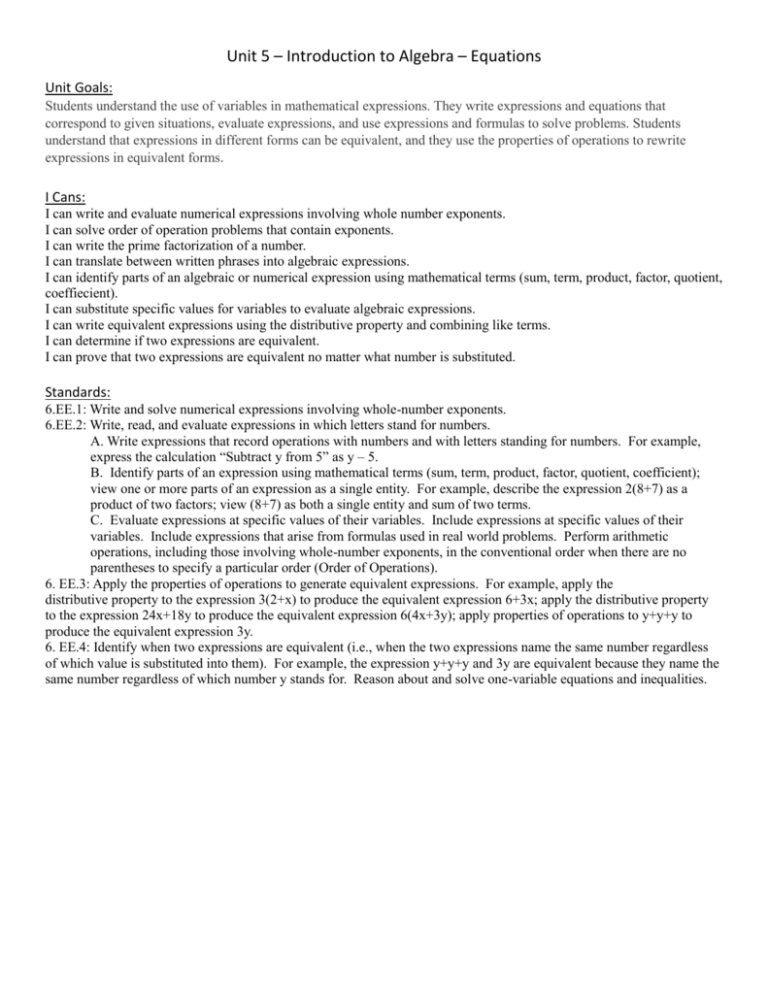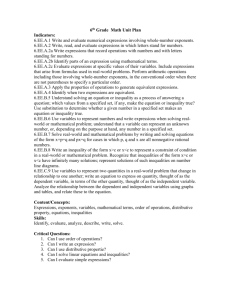3rd Quarter Content
advertisement

Unit 5 – Introduction to Algebra – Equations Unit Goals: Students understand the use of variables in mathematical expressions. They write expressions and equations that correspond to given situations, evaluate expressions, and use expressions and formulas to solve problems. Students understand that expressions in different forms can be equivalent, and they use the properties of operations to rewrite expressions in equivalent forms. I Cans: I can write and evaluate numerical expressions involving whole number exponents. I can solve order of operation problems that contain exponents. I can write the prime factorization of a number. I can translate between written phrases into algebraic expressions. I can identify parts of an algebraic or numerical expression using mathematical terms (sum, term, product, factor, quotient, coeffiecient). I can substitute specific values for variables to evaluate algebraic expressions. I can write equivalent expressions using the distributive property and combining like terms. I can determine if two expressions are equivalent. I can prove that two expressions are equivalent no matter what number is substituted. Standards: 6.EE.1: Write and solve numerical expressions involving whole-number exponents. 6.EE.2: Write, read, and evaluate expressions in which letters stand for numbers. A. Write expressions that record operations with numbers and with letters standing for numbers. For example, express the calculation “Subtract y from 5” as y – 5. B. Identify parts of an expression using mathematical terms (sum, term, product, factor, quotient, coefficient); view one or more parts of an expression as a single entity. For example, describe the expression 2(8+7) as a product of two factors; view (8+7) as both a single entity and sum of two terms. C. Evaluate expressions at specific values of their variables. Include expressions at specific values of their variables. Include expressions that arise from formulas used in real world problems. Perform arithmetic operations, including those involving whole-number exponents, in the conventional order when there are no parentheses to specify a particular order (Order of Operations). 6. EE.3: Apply the properties of operations to generate equivalent expressions. For example, apply the distributive property to the expression 3(2+x) to produce the equivalent expression 6+3x; apply the distributive property to the expression 24x+18y to produce the equivalent expression 6(4x+3y); apply properties of operations to y+y+y to produce the equivalent expression 3y. 6. EE.4: Identify when two expressions are equivalent (i.e., when the two expressions name the same number regardless of which value is substituted into them). For example, the expression y+y+y and 3y are equivalent because they name the same number regardless of which number y stands for. Reason about and solve one-variable equations and inequalities. Unit 6 – Introduction to Algebra – Inequalities and Dependent and Independent Variables Unit Goals: Students know that the solutions of an equation are the values of the variables that make the equation true. Students use properties of operations and the idea of maintaining the equality of both sides of an equation to solve simple one-step equations. Students construct and analyze tables, such as tables of quantities that are in equivalent ratios, and they use equations (such as 3x = y) to describe relationships between quantities. I Can’s: I can determine from a set of numbers, which value makes an equation or an inequality true. I can substitute a given number for a variable in an equation or an inequality to determine if it is a solution. I can write an expression, equation, or inequality for real-world mathematical problems containing one unknown. I can define inverse operations. I can solve one-variable equations using inverse operations. I can graph solutions to an inequality on a number line. I can define and give examples of independent and dependent variables. I can write an equation to express one quantity (dependent) in terms of the other quantity (independent). I can analyze the relationship between dependent and independent variables using tables and graphs. I can identify the equation being represented in a table or graph. Standards: 6. EE.5: Understand solving an equation or inequality as a process of answering a question: which values from a specified set, if any, make the equation or inequality true. Use substitution to determine whether a given number in a specified set makes an equation or inequality true. 6.EE.6: Use variables to represent numbers and write expressions when solving a real-world or mathematical problem; understand that a variable can represent an unknown number, or, depending on the purpose at hand, any number in a specified set. 6. EE.7: Solve real-world and mathematical problems by writing and solving equation of the form x+p=q and px=q for cases in which p, q, and x are all nonnegative rational numbers. 6. EE.8: Write an inequality of the form x˃c or x˂c to represent a constraint or condition in a real-world or mathematical problem. Recognize that inequalities of the form x˃c or x˂c have infinitely many solutions; represent solutions of such inequalities on number line diagrams. 6.EE.9: Use variables to represent two quantities in a real-world problem that change in relationship to one another; write an equation to express one quantity, thought of as the dependent variable, in terms of the other quantity, thought of as the independent variable. Analyze the relationship between the dependent and independent variables using graphs and tables, and relate these to the equation. Unit 7 – Geometry Unit Goals: Students reason about relationships among shapes to determine area, surface area, and volume. They find areas of right triangles, other triangles, and special quadrilaterals by decomposing these shapes, rearranging or removing pieces, and relating the shapes to rectangles. Using these methods, students discuss, develop, and justify formulas for areas of triangles and parallelograms. Students find surface areas of prisms and pyramids by decomposing them into pieces whose area they can determine. They reason about right rectangular prisms with fractional side lengths to extend formulas for the volume of a right rectangular prism to fractional side lengths. They prepare for work on scale drawings and constructions in Grade 7 by drawing polygons in the coordinate plane I Can’s: I can find the area of a special quadrilateral. I can find the area of a triangle. I can find the area of irregular figures composed of triangles and quadrilaterals. I can draw polygons in the coordinate plane when given coordinates. I can use coordinates to find the distance between two points on a coordinate plane. I can find the volume of a right rectangular prism using unit cubes. I can calculate the volume of a right rectangular prism using the volume formula. I can represent a three-dimensional figure using nets made up of rectangles and triangles. I can use the net of a figure to find surface area. Standards: 6.G.1: Find the area of right triangles, other triangles, special quadrilaterals, and polygons by composing into rectangles or decomposing into triangles and other shapes; apply these techniques in the context of solving realworld and mathematical problems. 6. G.2: Find the volume of a right rectangular prism with fractional edge lengths by packing it with unit cubes of the appropriate unit fraction edge lengths, and show that the volume is the same would be found by multiplying the edge lengths of the prism. Apply the formulas V=lwh and V=bh to find volumes of right rectangular prisms with fractional edge lengths in the context of solving real-world and mathematical problems. 6.G.3: Draw polygons in the coordinate plane given coordinates for the vertices; use coordinates to find the length of a side joining points with the same first coordinate or the same second coordinate. Apply these techniques in the context of solving real-world and mathematical problems.







